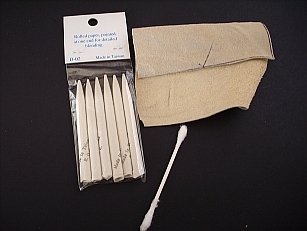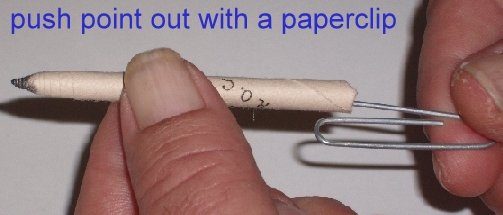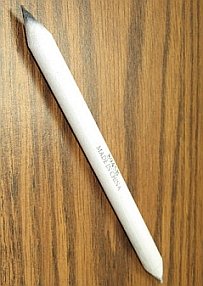Blending Utensils
Many Blending Utensils can be fashioned from simple household items.
Blending utensils will be necessary If you plan on blending to create the shadows in your drawings.
Not every artist uses a blending technique to create shadows. An artist may use a technique called cross-hatching, a method of creating shadows by using intersecting lines.
Some artists create their values (the lights and shadows) by varying the amount of pressure they put on the paper, while others use a layering method.
If you are interested in blending your values, this is the place you should be.
There are a great number of things that you can use as blending utensils.
First there are the standard blenders...
- tortillions
- stumps
- artist's chamois
Tortillions
Tortillions are basically a piece of paper rolled into a tight cone. They're nice for blending small areas.
Making Your Own Tortillions
If you would rather save some money and make your own tortillions...
- Unroll a tortillion, making sure you pay attention to how it was rolled up.
- Lay the unrolled tortillion down flat on a piece of drawing paper that has some texture to it.
- Draw around your tortillion template.
- Cut-out the newly drawn pattern.
- Roll the pattern up like the original was rolled up, (you did pay attention to how it was rolled up, right?)
- Use a piece of tape to hold your new tortillion together.
I prefer to save time rather than the money, and buy mine pre-rolled. Actually I lose patience while trying to roll them up, as my dexterity is not that good anymore. But if you're free of arthritis and would like to "give it a go", then by all means do so.
You should use the tortillion at an angle. When used vertically, the tip will get pushed back into itself and become blunt.
If this occurs, take a large paper-clip (or similar object) and push it through the bottom until the point is pushed back out to a point.
Use a new, clean tortillion for light, subtle shading. As a tortillion becomes "dirty" it can be used to blend out darker areas. Some artists keep them in groups according to their degree of "dirtiness".
These blending tools are pretty easy to find at any good art supply store. They are usually packaged in plastic bags of 6 or more.
Blending Stumps
These blending utensils are made out of felt paper. They are solid and pointed on both ends, and can be sharpened with fine sandpaper or an emery board when they become blunt. Just make sure you sharpen them by going in one direction... towards the point.
Another thing that makes these nice is that you can clean them with a kneaded eraser.
If you're using colored pencils or pastels make sure you keep your tortillions or stumps separated by the colors used to blend with them... unless you want the different colors mixed together.
You can find blending stumps in a variety of sizes.Artist's Chamois
A chamois is basically a piece of soft leather.
It's commonly used in large pieces to dry cars, and you can get them anywhere auto parts are sold. Just soak it in dish-washing detergent overnight, and then rinse it in the washing machine in plain water. Then cut it into the size pieces you need.
If you decide to purchase a chamois from an art supply store, you will pay more for it. You will not however, need to soak it to remove any oils from it. I haven't used any synthetic chamois, so I can't give you any advice as to the usefulness of them.
Now, here are some of the non-conventional blending
tools you can use.
will make this short and sweet: you can use anything that will blend cleanly, and without damaging your paper.
So don't use anything with chemicals or oils in it, and don't use sandpaper.
There you have it! Try everything you can get your hands on. Blending utensils are everywhere.
I've used...
- paper towels
- facial tissues
- cotton swabs
- art brushes
- make-up applicators
- various pieces of material
Just don't use your fingers unless you want the possibility of leaving a fingerprint on your work.
Blenders are all around you. Don't be shy about using something for the first time...you just might be pleasantly surprised.
Of course you might try out new blenders before using them on a serious piece. I mean you never know how the medium you're using will react to the blending.
Have a ball, and please let me know what kinds of unique blending utensils you've tried and have worked for you.
Home> Drawing Supplies> Blending Utensils
Subscribe to my Newsletter


